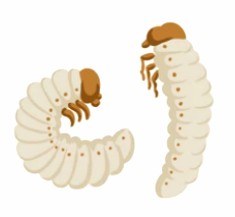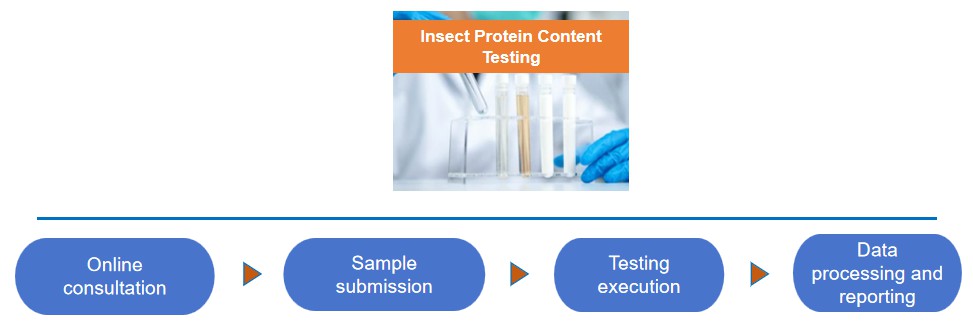Insect Protein Content Testing Services
Insect protein serves as an important source of protein, characterized by its high efficiency, environmental friendliness, and renewability. Insects are rich in high-quality protein, essential amino acids, and trace elements, providing crucial support for applications such as feed additives, food ingredients, and dietary supplements. The determination of insect protein content holds significant importance for the development of insect-based products. Lifeasible is dedicated to research in the field of insects, offering comprehensive, precise, and rapid insect protein content testing services.

What We Can Offer?
- Kjeldahl method. This technique uses concentrated sulfuric acid and a catalyst to digest the sample, converting organic nitrogen into ammonia, which is then absorbed by boric acid and titrated to determine the nitrogen content, ultimately used to calculate protein content. As the currently widely adopted legal standard method, it is characterized by high accuracy. Additionally, we have improved upon this traditional technique, including the use of an automatic Kjeldahl nitrogen analyzer to enhance efficiency and the optimization of digestion conditions to reduce time.
- Nessler's method. This technique utilizes the reaction between ammonia and Nessler's reagent to form a yellow complex, which is then measured colorimetrically to determine nitrogen content. It is characterized by its simplicity, high sensitivity, and suitability for batch testing.
- Other conventional methods. Additionally, we can tailor our approach to client requirements by employing techniques such as ultraviolet spectrophotometry, the biuret method, advanced ultrasound-assisted extraction (UAE), and microwave technology, as well as non-nitrogen determination methods to accurately measure insect protein content.
Our Specific Services
- Total protein content quantification. We utilize various advanced technical methods to help customers determine the total nitrogen content in insect samples and ultimately convert it to protein content.
- Amino acid profile analysis. After enzymatic hydrolysis, 20 common amino acids are quantified using high-performance liquid chromatography (HPLC) or ultra-high-performance liquid chromatography (UPLC) to assess the ratio of essential amino acids.
- Rapid near-infrared (NIR) screening. We establish near-infrared spectroscopy models suitable for various insect matrices, enabling high-throughput, non-destructive protein estimation.
- Protein peptidomics and structural analysis (optional). We identify major protein components and potential allergens via mass spectrometry (LC–MS/MS), providing in-depth data for safety assessments and functional studies.
Our Advanced Technology Platform
| Nitrogen determinator and automated combustion analyzer |
We utilize advanced instruments that can accurately determine the total nitrogen content, supporting the automated processing of both single and batch samples, with a daily testing capacity of several thousand samples. |
| High-performance/ultra-high-performance liquid chromatography system (HPLC/UPLC) |
When combined with a fluorescence or UV detector, it enables high-sensitivity separation and quantification of amino acids, with a detection limit as low as 0.1 μg/mL. |
| Fourier transform near-infrared spectrometer (FT-NIR) |
We have established multi-model algorithms (PLS, SVM, etc.) to support rapid protein estimation for different insect species and processing forms. |
| Liquid chromatography-mass spectrometry system (LC–MS/MS) |
Our technology platform can be used for proteomics pretreatment and high-resolution identification, enabling qualitative and accurate quantitative analysis of peptides in complex samples. |
Our Testing Process
- Online consultation. Customers can place orders online through our official website or call our customer service hotline for consultation.
- Sample submission. Customers provide fresh or dried insect samples as required, ensuring that sample labels and batch information are complete.
- Requirement communication and plan formulation. The technical team communicates one-on-one to determine the testing items, methods, and sample pretreatment plan.
- Testing execution. We strictly follow SOP procedures for sample pretreatment, testing, and quality control. This step includes sample preparation and sample testing.
- Data processing and reporting. After a secondary review of the raw data, we issue electronic or paper testing reports and provide professional interpretations.
- After-sales support. We can provide result discussions, method optimization, and long-term quality monitoring services according to customer needs.
 Fig.2 Our experimental process. (Lifeasible)
Fig.2 Our experimental process. (Lifeasible)
Why Choose Us?
- Accuracy. Our rigorous quality control system ensures the accuracy of test results.
- Customization. We can provide customized testing solutions based on different insect species and processing methods.
- Professional team. Our team of experts consists of specialists in biochemistry, proteomics, and data analysis, with extensive experience in insect research.
- Data services. In addition to raw data, we can also provide value-added reports such as statistical analysis, trend comparisons, and quality control recommendations.
Lifeasible specializes in providing professional, efficient, and accurate insect protein content testing solutions to support advances in insect research. If you are interested, please feel free to contact us.
For research or industrial raw materials, not for personal medical use!

 Fig.2 Our experimental process. (Lifeasible)
Fig.2 Our experimental process. (Lifeasible)